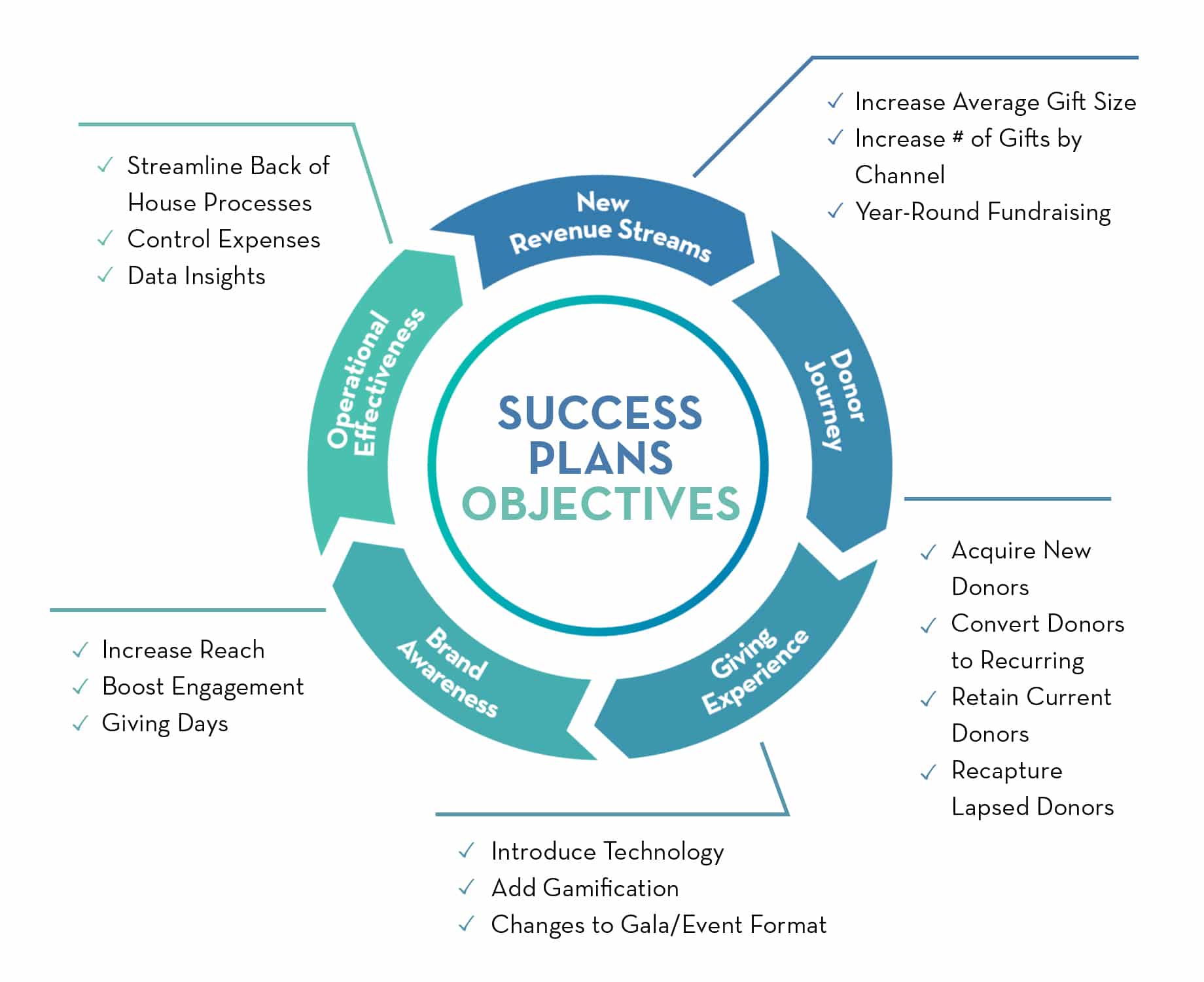Nonprofit Success Plan: Your Go-To Resource
The new year brings a fresh start to fundraising: new goals, new campaigns, new strategies and if all goes well, new donors. To stay on track, effective, and prepared, nonprofits are turning to Nonprofit Success Plans to fuel their growth.
Taking a cue from the for-profit world, organizations are planning out their annual fundraising from top level goals and priorities, down to the detailed campaigns and events.
These Nonprofit Success Plans are a lifeline for any nonprofit. In the fast-moving world of fundraising, where unforeseen changes often happen throughout the year, these plans outline your fundraising strategy A to Z.
As a busy nonprofit fundraiser, you are likely saying right now: “I’d love to have a success plan, but I don’t know how to even get started?”
Have no fear! We’ve assembled this step-by-step guide to help your nonprofit build a success plan today.
In this blog, we’ll cover the basics needed to create your own Nonprofit Success Plan:
- Form Planning Committee
- Define Your Success Plan Objectives
- Review Past Fundraising Performance
- Conduct Annual FUND Analysis
- Define Annual Goals & Success Plan
- Create Fundraising Calendar
- BONUS: Nonprofit Success Plan Checklist
Let’s get started!
How to Prepare Your Success Plan
The first step in nonprofit success planning is, well: to plan. We all like to jump in and get going. But taking a step back to get organized, provides the solid foundation you’ll need to develop a solid plan.
Here’s your preparation basics.
1. Form Planning Committee
No one said you had to do it alone. The more nonprofit viewpoints and voices involved in your Nonprofit Success Plan, the better. Even if you are a small nonprofit, you can recruit your board, donors, and experienced volunteers to help create your plan.
Remember your planning committee is the brain trust of any Nonprofit Success Plan, so be selective when recruiting your team. It’s also an opportunity to create and cultivate deeper relationships with your supporters. Look for individuals that are:
- Passionate about your mission. People who understand the mission of your organization, will ensure your cause, your programs and your needs form the basis of your plan.
- Experienced in fundraising, donor relations, business planning, and/or finance. You want a mix of skill sets and expertise on your success plan.
- Available and committed. Be sure to clearly outline the time commitment and role of the committee. Select people that can put in the time to help you plan.
- Look beyond donors. There are many ways to support a cause. Look beyond the typical donor, and try to engage top volunteers, staff, board members and local business partners.
2. Define Success Plan Objectives
The first thing you and your committee can do to build your success plan, is define your fundraising objectives for the year. This means outlining what you want to accomplish and the areas you will focus on.
We recommend bucketing your fundraising objectives into five core areas:
- New Revenue Streams: Strategies to grow revenue.
- Donor Journey: Moving donors through their lifecycle. How you engage and show donor appreciation throughout your donor journey.
- Giving Experience: Leveraging technology to engage and convert donors.
- Brand Awareness: Increasing awareness and reach.
- Organizational Effectiveness: Improving fundraising efficiency.
Choose the areas under each bucket that you want to focus on in your Nonprofit Success Plan. You don’t need to tackle them all – start small and pick a few key that will drive impact in this year. Once you have objectives outlined, you’ve taken the first step to planning success!
3. Review Past Fundraising Performance
Like any good roadmap, you need to know where you came from before you can get started! It’s now time to review prior performance. Think of this step as evaluating last year’s balance sheet.
Assess your fundraising at both the macro and micro level, so that you have a full view and historical baseline to inform your nonprofit success plan.
Promise, this too can be easy! For OneCause customers, just download or export your fundraising analytics. Or for those using donor databases, accounting software or excel, grab your data from there. No matter what you use, the important thing is to review past data!
To determine past performance start with these questions:
- What did we raise last year?
- What was our year-round fundraising strategy? How many campaigns and events did we execute?
- What were our donor stats (avg. donation, avg. per event, avg. per campaign)?
- What was our performance to budget?
- Were we up or down over prior year?
- Where did we see an increase in fundraising revenue (Avg. Gift size, Increase by channels)?
Once you are armed with your basic fundraising data, it’s time to identify where your fundraising is meeting or missing the mark.
4. Conduct Annual FUND Analysis (Revenue Stream, Upgrades, Net New, Donor Segments)
This next step is often overlooked. In benchmarking nonprofits from all over the country, those that are achieving fundraising excellence, perform some form of a FUND analysis as part of their success planning.
The great benefit of a FUND Analysis is that you segment your fundraising through the lens of ongoing donor engagement (i.e., the fundraising journey).
Complete these FUND steps to identify your growth targets and improvement areas. Ask yourself the following questions:
- Fundraising Streams: areas that make up your fundraising revenue.
- Where did we originate our fundraising revenue (e.g., events, campaigns, online, major gifts, direct mail)?
- What was the average dollar amount in each area? How many donors?
- What areas were above goal? What areas were flat? What areas fell short of goal?
- Which of our campaigns used technology and how did they perform?
- What campaigns and events generated the most engagement?
- Upgrades: moving existing donor to higher levels.
- Where did we have the most upgrades (e.g., events, campaigns, online, major gifts, direct mail, other)?
- What was the average dollar amount in each area? How many donors?
- How many individual donations in each area?
- New Donor Management: attracting and converting new donors.
- What brought in the most net new/first-time supporters (e.g., events, campaigns, online, major gifts, direct mail)?
- What was the average dollar amount in each area? How many donors?
- How many individual donations in each area?
- Donor Segments: groupings used to identify your donors.
- What are your donor segments? (e.g., demographic, gift type, funding area, geographic, donation levels)?
- Where did you see the most donor retention? Donor churn?
- Where did you see the biggest revenue gains? Loses?
Conducting a FUND Analysis requires a little more time upfront, but the investment will certainly pay off. Armed with this data, you will be able to create and measure the where, how and who of your nonprofit success plan.
5. Define Annual Goals & Success Plan
Now the fun really begins. It’s time to set your goals and create your actual Nonprofit Success Plan. Let’s get ready to grow your fundraising!
Take your performance data and your FUND Analysis and plug it into any Excel worksheet or use our easy template.
- Input Past Revenue & Current Goals
- Enter Performance by Area
- Enter results of FUND Analysis
- Add Annual Goals based on team input and growth needs
Congratulations! You’ve got your Nonprofit Success Plan. But before you jump in and start executing, it’s a good practice to get your planning on the fundraising calendar.
6. Create Fundraising Calendar
Last step into your success planning. Look at the year ahead and plot your fundraising activities large and small.
For each month, add your macro and micro campaigns and events, paying special attention to making sure you have a balance of fundraising types.
- Fundraising campaigns: online, direct mail, annual fund
- Fundraising events: galas, auctions, ticketed events, peer-to-peer
- Major gift or capital drives
- Giving & Awareness Day Campaigns days
This annual calendar will be your fundraising blueprint for the year. The fundraising calendar works hand in hand with your Nonprofit Success Plan; think of it as your official schedule for all you will accomplish this year.
Be sure to share both your Nonprofit Success Plan and Fundraising Calendar with your board, team, and key volunteers to get everyone aligned, excited, and on the path to fundraising excellence!
Bonus: Nonprofit Success Plan Checklist
Now that you’ve nailed your Nonprofit Success Plan, it’s time to rest up and prepare to rock the year! To keep it easy, we’ve created this template for you, to summarize the high-level steps for you and your team to follow.
These steps will ensure nothing slips through the cracks when you’re planning your most amazing fundraising year yet!
- Recruit your planning committee. Assemble a team with a variety of experience, nonprofit viewpoints and voices skill sets.
- Define your success objectives set your fundraising objectives for the year.
- Review past fundraising performance to assess your fundraising at both the macro and micro level, to create a historical baseline to use in your planning.
- Conduct a FUND Analysis to identify your growth targets and improvement areas.
- Define Annual Goals & Success Plan. It’s time to set attainable goals and create your Nonprofit Success Plan to grow your fundraising.
- Create Your Fundraising Calendar. Build your fundraising blueprint and official schedule for all you will execute and accomplish this year.
Having a success plan in place can help your nonprofit chart a course for fundraising excellence. Try it, make it your own, and don’t be afraid to revise it. Things move fast in fundraising, so adjust as needed.
Our Customer Success team stands ready to help you on your path to fundraising success. Feel free to reach out, if you would like to discuss your Nonprofit Success Plan today.
About the Authors: Dan Goode & Jennifer Mendoza, Directors of OneCause Customer Success

Jennifer Mendoza is a Director of Customer Success at OneCause, overseeing the Enterprise and Large Sized nonprofit success team. Jen has been helping nonprofits at OneCause since 2012, bringing her passion for fundraising excellence to thousands of events, and nonprofits from across the country.
Not Done? Keep Learning with OneCause!
Inspired to do some more research to execute your best success plan yet? Check out these resources to help get you there.










